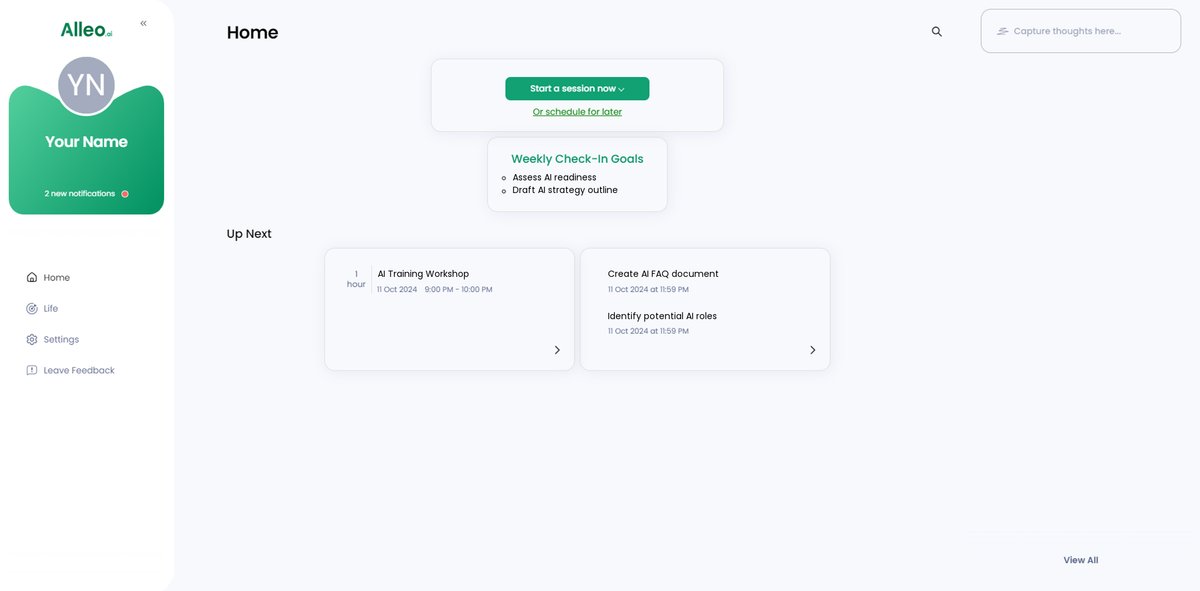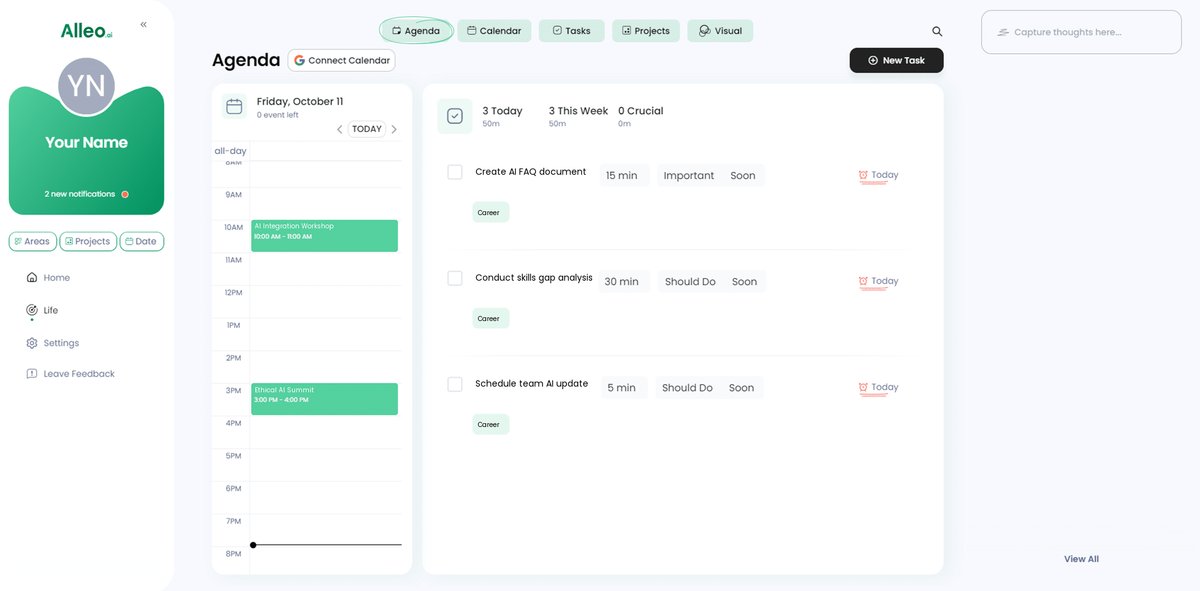6 Essential Ways Managers Can Adapt to AI Changes in the Workplace
Are you overwhelmed by the pace of AI advancements in your organization? Adapting to workplace AI changes can be challenging for many professionals.
As a life coach, I’ve helped many professionals navigate these challenges. In my experience helping clients adapt to rapid technological changes and workplace automation strategies, I often encounter common hurdles.
In this article, you’ll discover actionable strategies to manage AI integration effectively. We’ll explore AI tools for managers and techniques to keep your team competitive and up-to-date in the era of artificial intelligence in business.
Let’s dive in to explore AI-driven management techniques and employee upskilling for AI integration.

Understanding the Urgency of AI Adaptation
Many managers feel the pressure to keep up with AI advancements when adapting to workplace AI changes. They often face fears and misconceptions about artificial intelligence in business taking over jobs or creating confusion in the workplace.
In reality, the struggle is real. Several clients report difficulty in integrating AI due to a lack of clear workplace automation strategies and understanding.
This leads to disrupted workflows and stressed teams, impacting AI-human collaboration in the workplace.
Some organizations have faced significant setbacks when AI tools for managers were introduced without proper planning. It’s crucial to address these challenges early when adapting to workplace AI changes.
Remember, this isn’t just a technological shift; it’s a cultural one too. Embrace the change, and you’ll find your team more adaptable and resilient in the AI era.

Building a Roadmap for AI Adaptation
Overcoming this challenge requires a few key steps. Here are the main areas to focus on to make progress in adapting to workplace AI changes:
- Develop an AI Integration Strategy and Roadmap: Conduct readiness assessments and create phased plans for AI deployment, considering workplace automation strategies.
- Train Managers on AI Capabilities and Limitations: Organize workshops and mentorship programs to educate managers on AI tools and AI-driven management techniques.
- Communicate AI Changes Transparently to Employees: Develop communication plans and hold town hall meetings for updates on artificial intelligence in business.
- Foster a Culture of Continuous Learning and Adaptation: Encourage innovation and recognize adaptability in the workplace, focusing on AI-human collaboration.
- Implement Ethical AI Governance Frameworks: Establish ethics committees and develop clear AI usage policies, addressing ethical considerations of AI in management.
- Identify AI-Enhanced Roles and Reskilling Needs: Perform skills gap analyses and design targeted reskilling programs for employee upskilling for AI integration.
Let’s dive in to explore these strategies for adapting to workplace AI changes!
1: Develop an AI integration strategy and roadmap
Creating an AI integration strategy and roadmap is essential for guiding your organization through AI adoption smoothly, especially when adapting to workplace AI changes.
Actionable Steps:
- Conduct a comprehensive AI readiness assessment. Use tools to audit current processes and find opportunities for artificial intelligence in business integration.
- Create a phased implementation plan. Outline specific milestones and timelines for deploying AI technologies as part of your workplace automation strategies.
- Allocate resources and budget for AI projects. Secure funding and assign dedicated teams to manage AI initiatives and implement AI-driven management techniques.
Explanation: These steps are crucial because they provide a structured approach to AI integration. By assessing readiness, you can identify gaps and opportunities for adapting to workplace AI changes.
A phased plan ensures manageable progress, and allocating resources ensures successful implementation. According to NIST’s AI Risk Management Framework, effective planning and resource allocation are key to trustworthy AI implementation and AI-human collaboration in the workplace.
Taking these steps will set a strong foundation for your AI journey and prepare your team for future advancements in workplace AI changes.
2: Train managers on AI capabilities and limitations
Equipping managers with knowledge about AI’s potential and boundaries is crucial for successful integration and adapting to workplace AI changes.
Actionable Steps:
- Organize interactive AI training workshops. Host sessions that educate managers on AI tools and their practical applications in business.
- Implement a mentorship program. Pair managers with AI experts for personalized guidance and support on workplace automation strategies.
- Provide continuous learning opportunities. Offer access to online courses and certifications in AI to ensure ongoing education and employee upskilling for AI integration.
Explanation: These steps are essential because they ensure managers understand both the strengths and limitations of AI. Training workshops create a solid foundation, while mentorship programs offer tailored support for adapting leadership styles for the AI era.
Continuous learning keeps managers up-to-date with the latest AI trends. According to Forbes, ongoing education is critical for adapting to AI advancements.
Key benefits of manager AI training include:
- Enhanced decision-making capabilities using AI-driven management techniques
- Improved team leadership in AI-driven environments
- Increased confidence in leveraging AI tools for managers
This approach will empower managers to lead their teams through the AI transition effectively, focusing on AI-human collaboration in the workplace and future-proofing management skills for AI.

3: Communicate AI changes transparently to employees
Open communication is key to easing employees’ concerns and ensuring smooth AI integration when adapting to workplace AI changes.
Actionable Steps:
- Develop a comprehensive communication plan. Create and distribute a detailed FAQ document addressing AI-related changes and workplace automation strategies.
- Hold regular town hall meetings. Schedule monthly sessions to discuss AI updates, gather employee feedback, and address AI impact on workplace productivity.
- Create a dedicated AI information portal. Set up an internal website with resources, updates, and contact information for AI tools for managers and AI-human collaboration in the workplace.
Explanation: These steps matter because they promote transparency and trust within the organization when adapting to workplace AI changes.
A well-structured communication plan ensures everyone is informed about artificial intelligence in business and can voice their concerns.
Regular town hall meetings foster a sense of community and open dialogue about AI-driven management techniques.
According to Customer Experience Dive, transparency and communication are crucial during AI transitions to maintain employee engagement.
Transparent communication will help your team feel more involved and less anxious about adapting to workplace AI changes.

4: Foster a culture of continuous learning and adaptation
Creating a culture of continuous learning and adaptation is crucial for adapting to workplace AI changes and keeping your team agile in the face of artificial intelligence in business advancements.
Actionable Steps:
- Encourage innovation and experimentation. Launch an AI innovation lab where employees can test new AI tools for managers and workplace automation strategies.
- Recognize and reward adaptability. Implement a recognition program that celebrates employees who embrace AI changes and demonstrate AI-human collaboration in the workplace.
- Promote cross-functional collaboration. Form interdisciplinary teams to work on AI projects, share knowledge, and develop AI-driven management techniques.
Explanation: These steps are essential because they foster a proactive and engaged workforce. Encouraging innovation allows employees to explore AI applications freely, supporting employee upskilling for AI integration.
Recognizing adaptability boosts morale and motivates others to embrace change. Cross-functional collaboration ensures diverse perspectives and expertise, helping to address ethical considerations of AI in management.
According to Asana, developing adaptability skills, such as problem-solving and open-mindedness, is vital for thriving in today’s workplace and adapting leadership styles for the AI era.
Fostering a learning culture will help your team stay competitive and prepared for future AI developments, enhancing AI impact on workplace productivity and future-proofing management skills for AI.

5: Implement ethical AI governance frameworks
Establishing ethical AI governance frameworks is crucial for ensuring responsible AI deployment and adapting to workplace AI changes.
Actionable Steps:
- Form an AI ethics committee. Assemble a team to oversee the ethical use of AI within your organization, considering AI-human collaboration in the workplace.
- Develop clear AI usage policies. Create guidelines that outline acceptable AI practices and ensure compliance with workplace automation strategies.
- Conduct regular AI ethics audits. Periodically review AI systems to ensure they align with ethical standards and AI-driven management techniques.
Explanation: These steps matter because they safeguard against biased outcomes and ensure transparency in AI usage, crucial for adapting to workplace AI changes.
Establishing an ethics committee and clear policies promotes accountability. Regular audits help maintain ethical standards and address the impact of AI on workplace productivity.
According to UNESCO, ethical considerations are vital for responsible AI development.
Key components of an ethical AI framework:
- Fairness and non-discrimination principles
- Transparency and explainability guidelines
- Privacy protection measures
Implementing these governance frameworks will foster trust and integrity in your AI initiatives, supporting the integration of artificial intelligence in business.

6: Identify AI-enhanced roles and reskilling needs
Identifying AI-enhanced roles and reskilling needs is vital for adapting to workplace AI changes and ensuring your team stays relevant and competitive.
Actionable Steps:
- Perform a comprehensive skills gap analysis. Use AI tools for managers to assess current skill levels and identify areas for improvement.
- Design targeted reskilling programs. Create customized training modules that upskill employees for AI integration and AI-enhanced roles.
- Implement career development plans. Offer personalized career paths that align with AI-driven job market demands and future-proof management skills for AI.
Explanation: These steps matter because they ensure your team is prepared for the evolving job landscape. Conducting a skills gap analysis helps pinpoint areas needing improvement.
Targeted reskilling programs provide focused training, and career development plans align employee growth with organizational needs. According to The HR Director, focusing on skill development is crucial for adapting to technological advancements.
High-demand skills in AI-enhanced roles:
- Data analysis and interpretation
- Machine learning algorithm development
- AI ethics and governance
Identifying and addressing these needs will help your team thrive amid AI changes and improve AI-human collaboration in the workplace.

Partner with Alleo on Your AI Journey
We’ve explored the challenges managers face adapting to workplace AI changes. Did you know you can work directly with Alleo to make this journey easier and faster, especially when it comes to AI-driven management techniques?
Setting up an account with Alleo is simple. Create a personalized plan tailored to your specific needs, focusing on workplace automation strategies and employee upskilling for AI integration.
Work with Alleo’s coach to overcome AI skills gaps and enhance your AI tools for managers toolkit.
The coach will follow up on progress, handle changes, and keep you accountable via text and push notifications, helping you adapt leadership styles for the AI era.
Ready to get started for free and boost your AI impact on workplace productivity? Let me show you how!
Step 1: Log In or Create Your Account
To begin your AI adaptation journey with Alleo, simply log in to your existing account or create a new one if you’re joining us for the first time.

Step 2: Choose Your AI Adaptation Focus
Select “Setting and achieving personal or professional goals” to address your specific AI integration challenges. This option will help you create a tailored plan to navigate the rapidly evolving AI landscape in your workplace, ensuring you stay competitive and confident in your leadership role.

Step 3: Select “Career” as Your Focus Area
Choose “Career” as your focus area to address AI adaptation challenges in your workplace, aligning with the article’s emphasis on professional growth and technological integration.

Step 4: Starting a coaching session
Begin your AI adaptation journey with an intake session to set up your personalized plan, discussing your organization’s specific challenges and goals for integrating AI technologies.

Step 5: Viewing and managing goals after the session
After your AI coaching session, check the app’s home page to review and manage the goals you discussed, allowing you to track your progress in adapting to AI changes in your organization.

Step 6: Adding events to your calendar or app
Use the app’s calendar and task features to schedule AI-related activities and track your progress in overcoming workplace AI challenges, ensuring you stay on top of your personalized adaptation plan.

Wrapping Up: Embracing AI with Confidence
As we conclude, it’s clear that adapting to workplace AI changes is a journey. Remember, you’re not alone in this.
Take proactive steps to integrate AI, and your team will thank you for implementing workplace automation strategies.
It’s about creating a structured plan, educating managers on AI-driven management techniques, and fostering a culture of continuous learning.
Also, focus on transparent communication and ethical considerations of AI in management to build trust.
Don’t forget to reassess skills and provide employee upskilling for AI integration opportunities.
Let’s make this transition to artificial intelligence in business smoother.
Alleo can be your partner in this journey, offering personalized support and guidance on AI-human collaboration in the workplace.
Start your free account today and see the difference it makes in adapting leadership styles for the AI era.
Together, we can navigate these changes confidently, future-proofing management skills for AI.